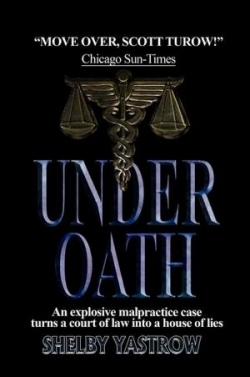Under Oath
The plaintiffs, defendants, and lawyers in Under Oath, Shelby Yastrow’s compelling legal novel, seek the truth, the whole truth, and nothing but the truth. According to plaintiff Tracey Walton, obstetrician Steven Sinclair acted negligently by failing to perform tests that would have diagnosed her daughter’s severe Down syndrome. Steven contends that he could not have diagnosed the condition with the information he had, which was based on tests Tracey requested and information she gave him regarding Angel’s conception. If the jury finds Steven negligent, his insurance company will have to pay millions to Tracey. Other disgruntled players include an agent from Steven’s insurance company, Tracey’s father, and her former husband.
Skillfully shifting from the point of view of one fleshed-out character to the next, Yastrow, who is a former lawyer, depicts the effects of the case on everyone involved and shows readers that no one is immune to wheeling and dealing. Unfortunately, the story’s ground level machinations make it hard to determine clear heroes and villains, as the author reveals the characters’ motivations.
Through the characterizations of Charlie Mayfield, Tracey’s lawyer, and Lewellen Beck, Steven’s lawyer, however, Yastrow does effectively submerge readers in the behind-the-scenes world of a trial: coaching witnesses on how to respond to questioning, bluffing and counter-bluffing as each side tries to get the other to settle, and taking advantage of the impression clothing and stance can have on a jury. Fortunately, the author elucidates the story’s legal language, as well as the complicated genetics of Down syndrome, for the lay reader. While learning about legal goings-on, fetal tests, and chromosomes, readers will enjoy an intense courtroom battle and its aftermath. While shrewd readers will guess the plot twist early on, the revelation remains shocking nonetheless. The story segues smoothly from legal procedural to a thrilling hunt for evidence before heading back into the courtroom for another nail-biting drama. An Illinois native, Yastrow knows his setting well, and gives readers a knowledgeable tour of Chicago and other locales in the Midwest.
Minor points may confuse readers, however. The novel is set in 1988. Because the year is not established right away, readers may be baffled by the lack of cell phones. Additionally, until readers learn the time in which the book occurs, they may be bewildered by Tracey’s refusal to schedule an ultrasound—a procedure that is now commonplace during pregnancy. Moreover, the author’s inaccurate characterization of Down syndrome as an illness or disease will likely annoy anyone with knowledge of the condition. Similarly, readers must keep in mind that much more is known about Down syndrome today than in 1988. Quibbles aside, Under Oath will appeal to fans of courtroom novels and thrillers alike.
Reviewed by
Jill Allen
Disclosure: This article is not an endorsement, but a review. The publisher of this book provided free copies of the book and paid a small fee to have their book reviewed by a professional reviewer. Foreword Reviews and Clarion Reviews make no guarantee that the publisher will receive a positive review. Foreword Magazine, Inc. is disclosing this in accordance with the Federal Trade Commission’s 16 CFR, Part 255.

